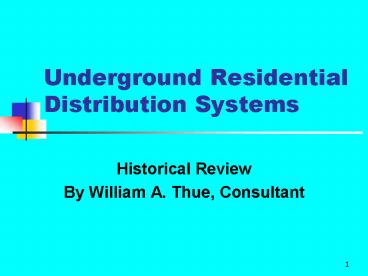Underground Residential Distribution Systems - PowerPoint PPT Presentation
1 / 27
Title:
Underground Residential Distribution Systems
Description:
Underground Residential Distribution Systems Historical Review By William A. Thue, Consultant Cable History 1812: First cable was used in Russia to detonate an ... – PowerPoint PPT presentation
Number of Views:515
Avg rating:3.0/5.0
Title: Underground Residential Distribution Systems
1
Underground Residential Distribution Systems
- Historical Review
- By William A. Thue, Consultant
2
Cable History
- 1812 First cable was used in Russia to
detonate an explosive with an electrical impulse - Strips of India rubber were wrapped around a pair
of copper conductors to fire a mine under the
Neva River in St. Petersburg
3
Cable History
- 1816 First experimental telegraph cable
- Ronalds made this cable as 500 foot lengths of
copper wire drawn into glass tubes joints were
sealed with wax. Cable placed in creosoted wooden
trough.
4
Cable History
- 1842 Morse submarine telegraph cables
- Copper wire saturated in pitch and covered with
strips of India rubber - In New York Harbor and Washington DC the next
year
5
Cable History
- 1844 Morse telegraph cables from Washington to
Baltimore - Four 16 copper conductors were insulated with
shellac and drawn into a swedged lead tube. Made
in 300 foot coils and plowed.
6
Cable History
- 1879 Edisons NYC dc lighting system
- Rigid buried system
- 2 or 3 copper rods insulated with jute were
pulled into 20 foot iron pipes filled with a
bituminous compound - Tube joints
7
Cable History
- 1885 Westinghouse ac system
- OVERHEAD AT 1,000 Volts!
8
Early Performance
- 1888 No arc wires had been placed underground
in either New York or Brooklyn. The experience in
Washington lead to the state-ment that no
insulation could be found that would operate for
2 years at 2,000 volts. In Chicago, all
installations failed except for lead covered
cables.
9
Early Performance
- TERRIBLLE until Edisons system
- By 1900, rubber cables in lead and installed in
ducts became the standard in NYC for lighting and
telegraph in subways - Paper insulation replaced rubber in the 1910s and
1920s
10
First URD Systems
- 1920s PILC or rubber cables
- Copper conductors
- Three phase 5 kV service
- Cables in ducts
- Transformers switches in dog house
vaults - Exclusive subdivisions
- Cost 4,000 per lot (avg house)
11
1950 Era URD
- Three phase 15 kV loop systems
- PILC rubber cables
- Cables in ducts with manholes
- Transformers switches in vaults
- Exclusive subdivisions
- Cost 2,000 per lot (Cadillac)
12
1965 Era of Beautification
- Single phase 15 kV systems
- Direct buried polyethylene cable
- Padmounted transformers
- New subdivisions
- In 1972, total cost 400/lot
13
What Were We Doing?
- Trying to get cost of underground the SAME as
overhead - Lowest reported at about 1.6 times an overhead
system - Average was 21 in 1975
- Builders paid the difference between overhead and
underground price of a TV added to mortgage --
200/lot
14
PolyethyleneThe Perfect Insulation
- 40 year life
- No problem with moisture
- Cheap
- Easy to splice with unskilled crews
- Most problems would be dig-ins
15
What did 40 Year Life Mean?
- A 1956 paper by Jack Crowdes said
- Half the samples (in a test) would fail by the
end of the 40th year.
16
What was meant byMoisture Resistant?
- Polyethylene did not absorb as much water as
rubber insulation - Rubber insulations would absorb 5 to 10 of their
weight when left in a water bath for 7 days
17
Low Cost
- Keep first cost as low as possible
- National pressure from builders
- Why worry about replacement cost since the cable
would last as long as the house? - Maintenance would be less than overhead
18
Workmanship no Problem
- ANYBODY can splice poly!
- No clean, dry environment needed
- No lead to wipe
- No hot compounds to pour
- Splicing and terminating can be done quickly and
inexpensively with premolded devices
19
Dig-ins the Only Problem
- 90 of all failures would be from dig-ins
- Fault location hardly needed
- (just find the smoking backhoe)
- Dig a bigger hole and then splice
20
A Few Little Problemsby 1970
- Failures without backhoes
- Failures within 2 to 3 years
- Treeing
- Neutral corrosion
- Fault location not so easy
- Customer dissatisfaction
- (they expected better service)
21
AEIC Cable Failuresper 100 miles, 1962-1975
22
AEIC Failures per 100 miles, 1962-1991
HMWPE
XLPE
EPR
TR-XLPE
23
Medium Voltage CableStandards Specifications
- 1920 NELA Paper cable spec.
- 1924 AEIC Paper cable spec.
- 1926 IPCEA VC cable standard
- 1935 IPCEA Rubber cable stand.
- 1961 IPCEA Poly cable stand.
24
Medium Voltage CableStandards Specifications
- 1969 AEIC poly cable interim
- 1971 AEIC poly cable spec.
- 1973 AEIC EPR spec.
25
15 kV Insulation Thickness
- 1920 Paper 165-190 mils
- 1930 Rubber 297 mils
- 1950 Poly 220 mils
- 1965 XLPE/EPR 175 mils
- 1995 urban ducts 165 mils
26
Importance of History
- Find out what works
- Find out what doesnt work
- Find out how to test new products
- Simply avoid same mistakes
27
Bright Future































